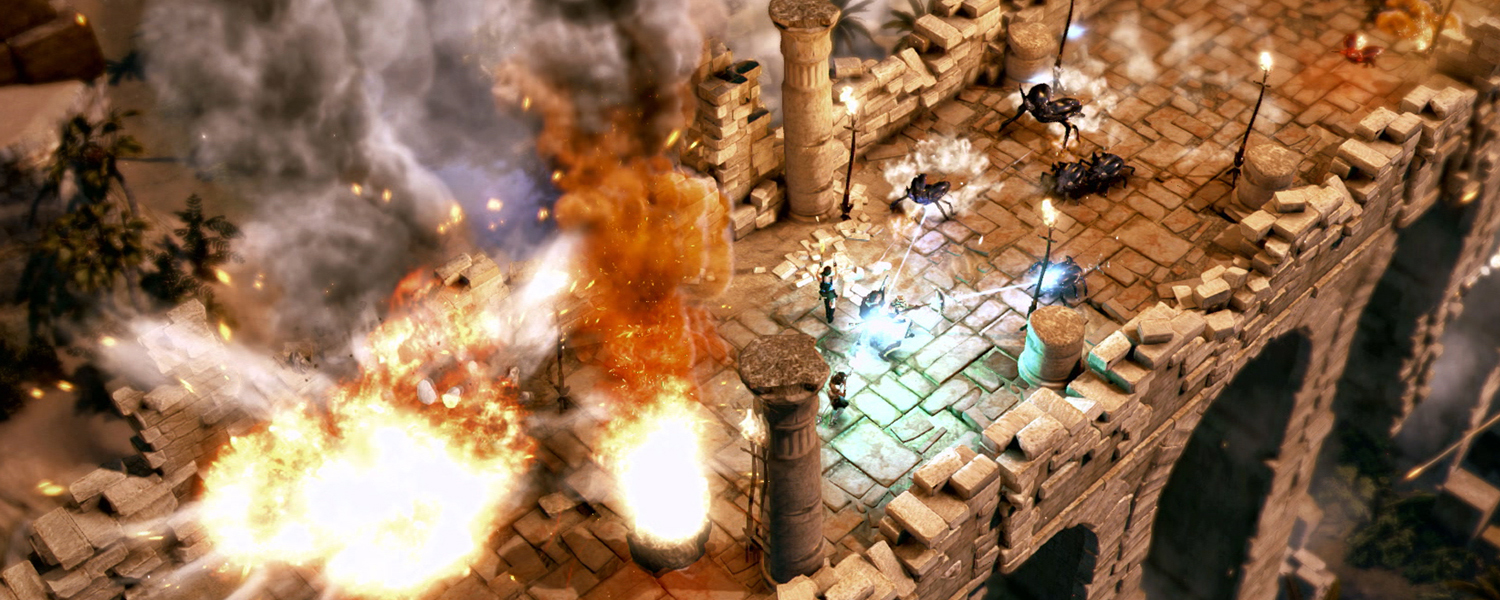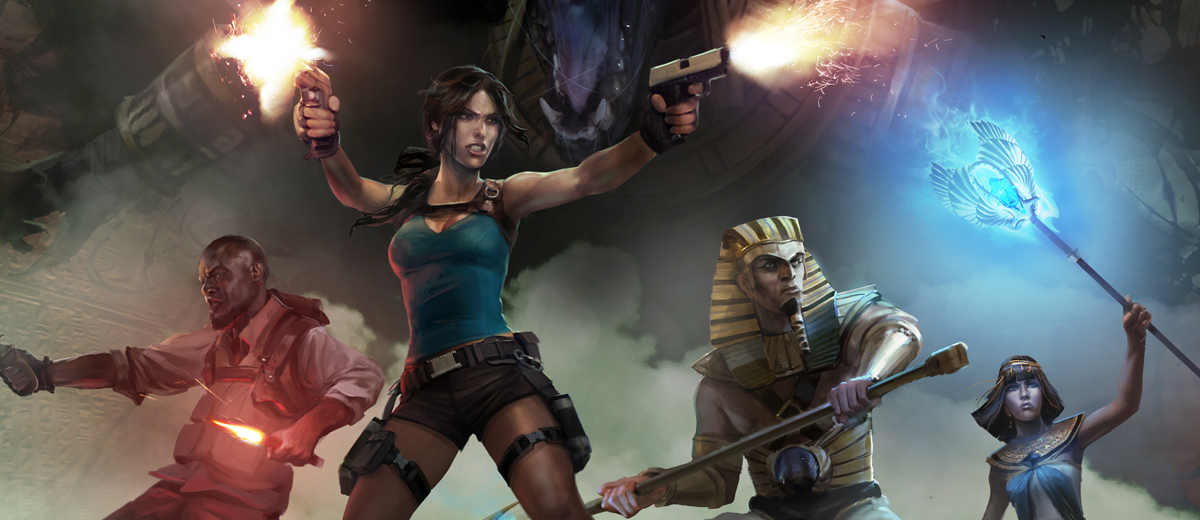
 Temple of Osiris takes place sometime after the previous game, the Guardian of Light. Whereas the original game was firmly rooted in Mayan mythology and folklore, Temple of Osiris explores Egyptian folklore and mythology instead. It’s a pretty well covered area of fiction in many facets of pop culture but it still does a serviceable job at giving Lara a nice bevy of tombs to, well, raid.
Temple of Osiris takes place sometime after the previous game, the Guardian of Light. Whereas the original game was firmly rooted in Mayan mythology and folklore, Temple of Osiris explores Egyptian folklore and mythology instead. It’s a pretty well covered area of fiction in many facets of pop culture but it still does a serviceable job at giving Lara a nice bevy of tombs to, well, raid.
Temple of Osiris has a pretty run of the mill storyline, however. In it, Lara travels to Egypt and teams up with rival treasure hunter Carter Bell to discover the many treasures of the Egyptian tombs. But when Horus and Isis are brought into the midst by an evil god named Set, Lara and Carter must join forces with them to take down the evil god and banish him back to where he came from.
The story itself is, as we mentioned, pretty standard. In fact it’s so generic that it feels like something you’d see in a Saturday morning cartoon version of Tomb Raider rather than the more serious stuff found in the other games. It’s not necessarily bad, it’s just there. It’s unfortunate considering that both Guardian of Light and Temple of Osiris have cheesy throwaway plots and no efforts have been made to improve between games.
 Taking place entirely in Egypt has allowed the developers to hone their presentation when it comes to the Temple of Osiris. It also means that there’s less of a variety in the environments when you compare them to the other games where Lara is able to jet set around the globe. But this isn’t necessarily a bad thing, as each area feels realistically connected and all looks like it adheres to a consistent visual style.
Taking place entirely in Egypt has allowed the developers to hone their presentation when it comes to the Temple of Osiris. It also means that there’s less of a variety in the environments when you compare them to the other games where Lara is able to jet set around the globe. But this isn’t necessarily a bad thing, as each area feels realistically connected and all looks like it adheres to a consistent visual style.
The temples and tombs you’ll explore look dilapidated and believably ancient. Ambient lighting flutters and behaves realistically whether it’s coming from lit torches on the walls or glowing and glistening ancient artefacts. In short – the game looks great and it has a great air or atmosphere to it that makes you want to go deeper and deeper into the tombs the more you play. There were some times where I questioned whether this game really had to be exclusive the newer generation of consoles since it doesn’t seem to be pushing them immensely but it still looks great regardless.
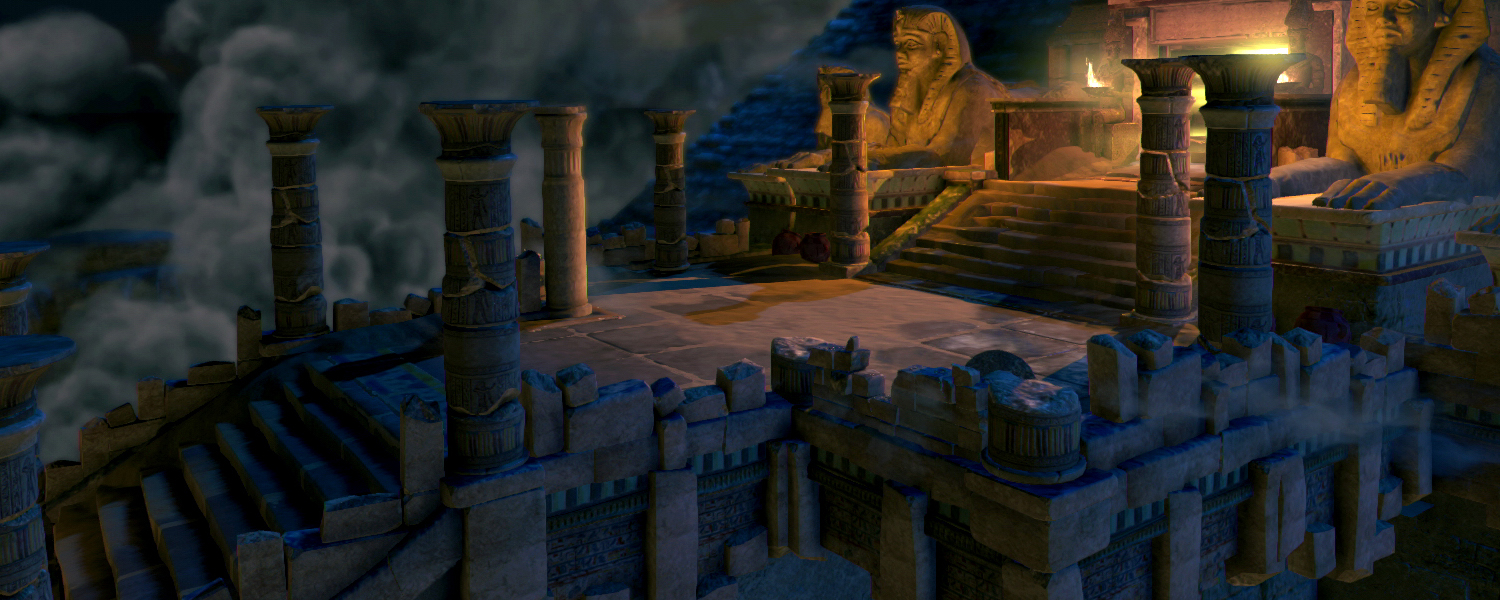 But there is one thing that might be an issue for some players, and that’s just how generic the art style seems to be. It’s almost as if the art team decided to just slap a royal Egyptian headdress on every animal they could and made them bipedal to create the enemies in the game. It’s an incredibly minor and admittedly personal complaint but it just seems like a really disappointing and typical way to create enemies from this era.
But there is one thing that might be an issue for some players, and that’s just how generic the art style seems to be. It’s almost as if the art team decided to just slap a royal Egyptian headdress on every animal they could and made them bipedal to create the enemies in the game. It’s an incredibly minor and admittedly personal complaint but it just seems like a really disappointing and typical way to create enemies from this era.
The voice work, on the other hand, is pretty stellar. Keeley Hawes returns to play Lara this time around as the story allegedly takes place in the old timeline – so those of you who enjoyed her dry and witty performance in Legend and Underworld will appreciate her return here too. The secondary characters, particularly Isis and Horus, sound great but the actors are definitely hamming it up. The soundtrack is great too – playing booming percussion to channel Indiana Jones during the adrenaline fuelled moments of the game while knowing just how and when to scale it back to calmer ambient pieces during exploratory segments of the game. It is admittedly slightly generic but it fits and complements the game so well it’s hard to fault.
 The Lara Croft games, since they’re a series now, have never been about capturing that exact Tomb Raider feel that the mainline titles have. Instead, it’s more of an isometric affair where Lara and her supporting cast can still raid tombs and solve puzzles – the core DNA of the franchise is here but it’s presented differently and at bit of a smaller scale to create a bit of a…..let’s say…..more intimate experience than the bigger games do. You’re dropped into a large hub area – which you can explore at your own leisure – or delve into the tombs which form the main missions of the game.
The Lara Croft games, since they’re a series now, have never been about capturing that exact Tomb Raider feel that the mainline titles have. Instead, it’s more of an isometric affair where Lara and her supporting cast can still raid tombs and solve puzzles – the core DNA of the franchise is here but it’s presented differently and at bit of a smaller scale to create a bit of a…..let’s say…..more intimate experience than the bigger games do. You’re dropped into a large hub area – which you can explore at your own leisure – or delve into the tombs which form the main missions of the game.
In each mission you’ll have to get from beginning to end, navigating through various obstacles and puzzles on the way. You’ll be equipped with the typical equipment you’d expect to find in a Tomb Raider game like a grappling hook and an array of weaponry designed to take down endangered fauna with. These more “typical” load outs are exclusive to the human characters of Lara and Carter. Isis and Horus, on the other hand, are able to use their magic staff to affect certain items in the environment and even shield themselves from certain attacks.
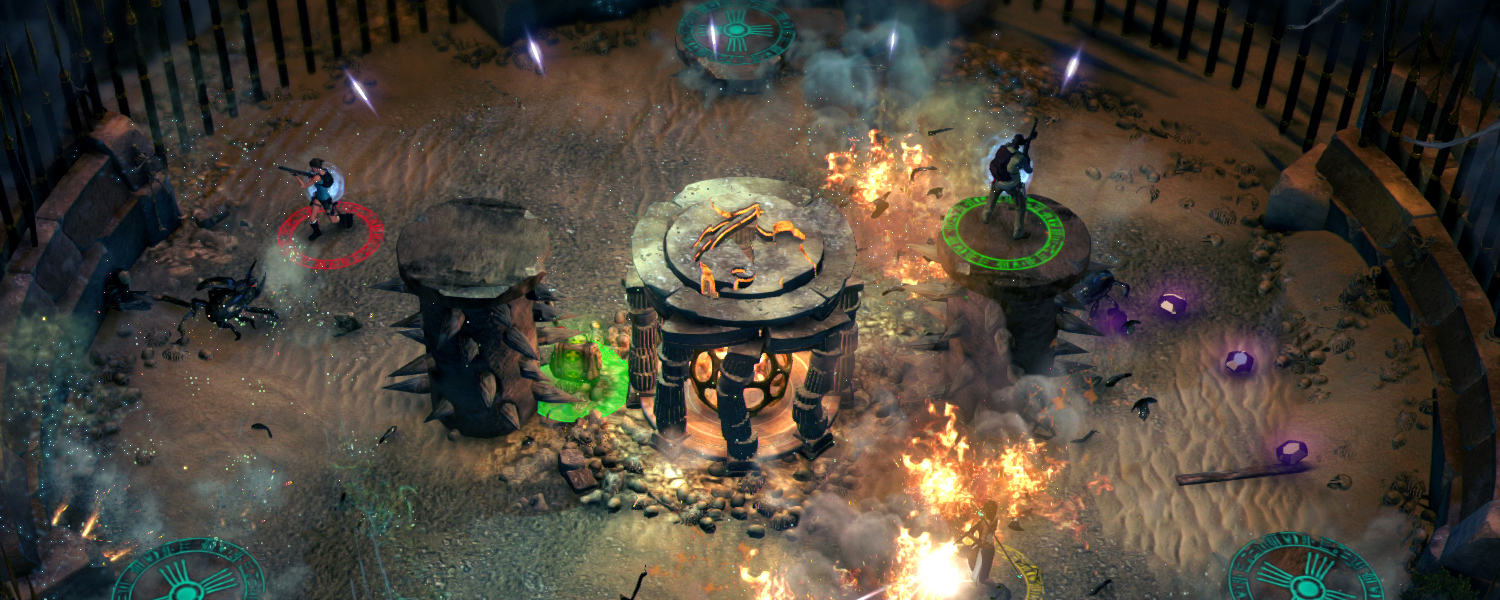 The entire game can be played co-operatively with up to four players, and as such that means that these abilities are split up across all four characters to ensure everyone has a role in the game when it comes to combat or even solving puzzles. Lara and Carter have the standard equipment while the demigods have the magical abilities. If you’re not one to play the game with friends, either online or off, the game simply gives Lara the staff that Horus and Isis use to give her those abilities. So essentially, the game scales rather well depending on how many people are playing. Guardian of Light did this well so it’s great to see Osiris doing just as well with four player characters.
The entire game can be played co-operatively with up to four players, and as such that means that these abilities are split up across all four characters to ensure everyone has a role in the game when it comes to combat or even solving puzzles. Lara and Carter have the standard equipment while the demigods have the magical abilities. If you’re not one to play the game with friends, either online or off, the game simply gives Lara the staff that Horus and Isis use to give her those abilities. So essentially, the game scales rather well depending on how many people are playing. Guardian of Light did this well so it’s great to see Osiris doing just as well with four player characters.
And it’s character interaction that really separates Temple of Osiris from its contemporaries. There’s all kinds of combinations of abilities that can be used in the game to assist the player – Lara can grapple onto other players to reach areas much more easily than if she were to do things by herself. Isis can shield herself with a magical barrier, only to have Lara propel her like a human cannonball using her remote mines. Heck, the magical barrier can even be used as a stepping stone in some of the more difficult puzzle moments. It’s this interplay between the characters abilities that makes playing the game by yourself and with friends as equally fun as each other.
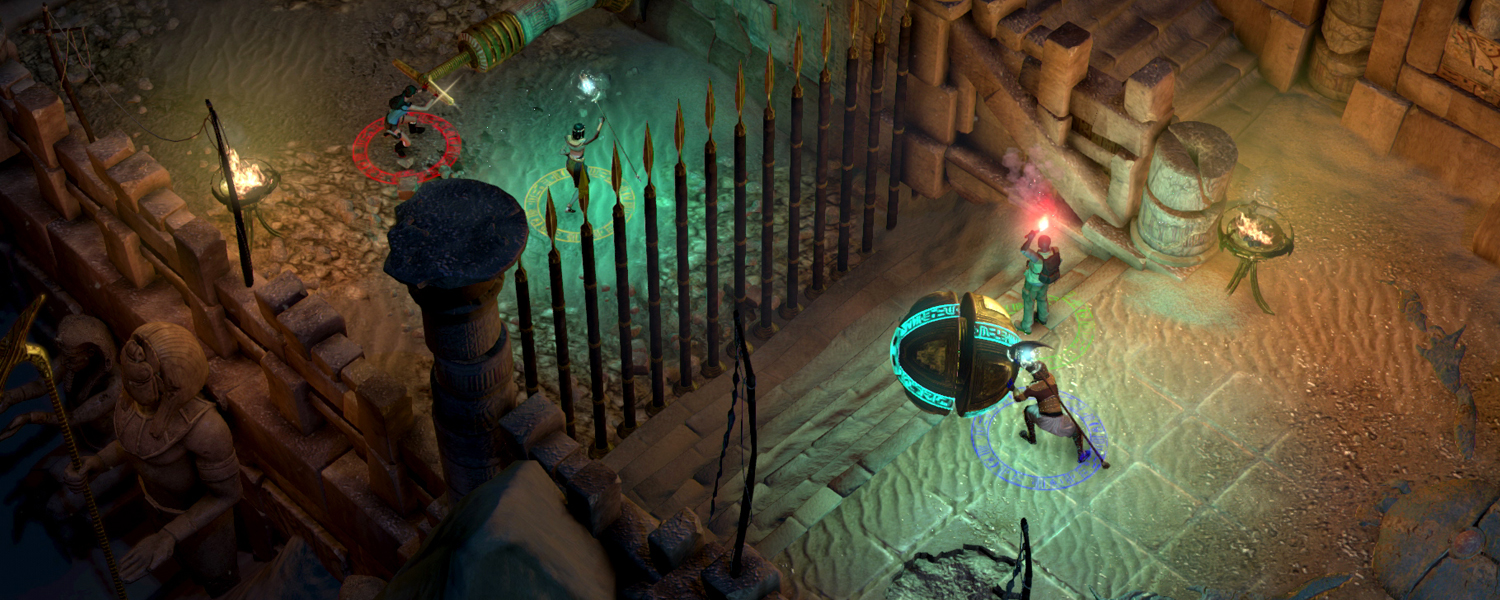 The puzzles themselves run the gamut from laughably easy all the way through to pretty hard. If you’re planning on playing the game solo then most of the puzzles will take some time to work out, especially in the game’s optional tombs. Playing with multiple players can really go either way – sometimes it’ll help you complete certain tasks quicker as you’ll have more people to delegate tasks to or it’ll hinder you if your team isn’t that great. So while the scaling of the puzzles isn’t particularly dynamic, it still ensures that all the players who are playing at the present moment will have something to do.
The puzzles themselves run the gamut from laughably easy all the way through to pretty hard. If you’re planning on playing the game solo then most of the puzzles will take some time to work out, especially in the game’s optional tombs. Playing with multiple players can really go either way – sometimes it’ll help you complete certain tasks quicker as you’ll have more people to delegate tasks to or it’ll hinder you if your team isn’t that great. So while the scaling of the puzzles isn’t particularly dynamic, it still ensures that all the players who are playing at the present moment will have something to do.
It wouldn’t be a Tomb Raider game without a wide arsenal of weapons to take down endangered animals with, and Temple of Osiris satisfies this trait in droves. Lara can play around with over twelve or so different weapons which can be used with the right directional stick to aim and fire. Players can also unlock amulets and rings which can be equipped on players to increase certain statistics, but usually at the cost of another. Such characteristics might imbue Lara’s bullets with flames, allowing her to solve certain puzzles much easier, but reduce her defence. It’s an admittedly simplistic system but it is something that’s easy to manage and play around with for the benefits but also not something you have to spend an immense time on to progress through the game.
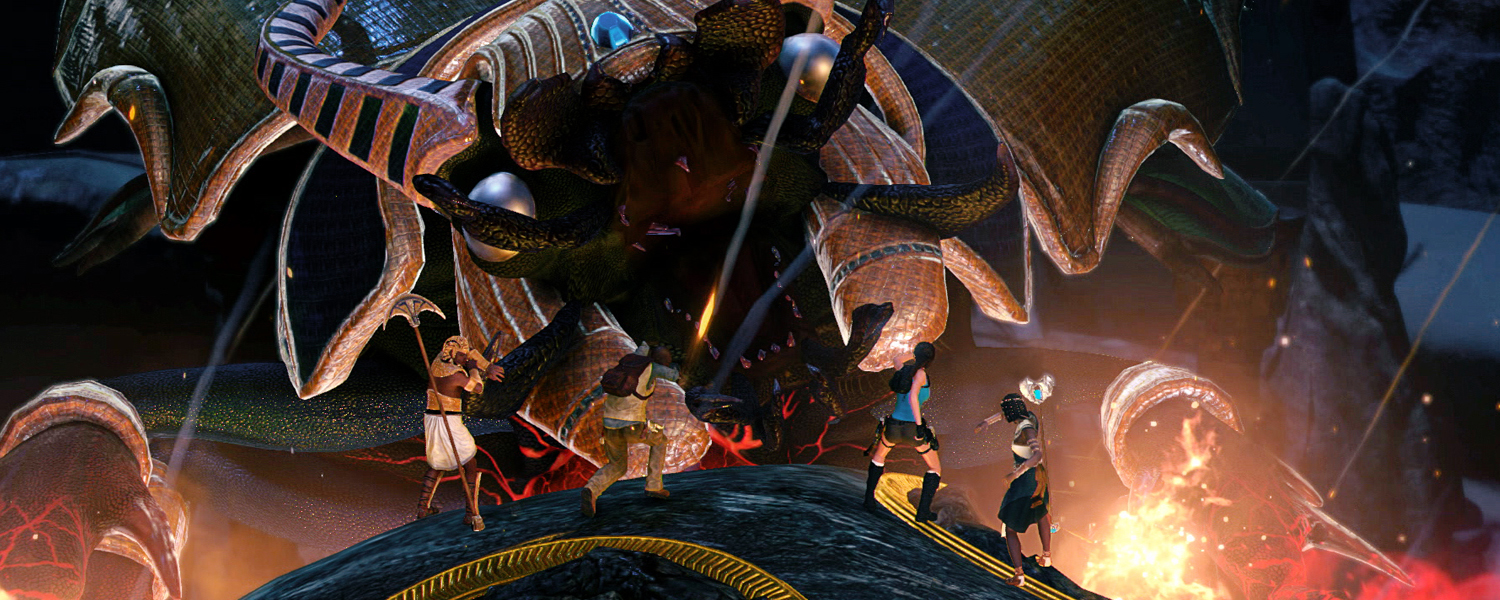 When you’re not exploring the main tombs, the game provides opportunity to explore the hub world itself which is littered with collectibles, combat challenges and optional tombs too. Optional tombs are a great little inclusion because they’re not compulsory content, so the developers have made them much more difficult and as such they provide a challenge. There is quite a bit of content here – with most players taking about seven to eight hours to complete the main story – but finding absolutely everything will take roughly fifteen to twenty hours, which represents incredible value given the asking price.
When you’re not exploring the main tombs, the game provides opportunity to explore the hub world itself which is littered with collectibles, combat challenges and optional tombs too. Optional tombs are a great little inclusion because they’re not compulsory content, so the developers have made them much more difficult and as such they provide a challenge. There is quite a bit of content here – with most players taking about seven to eight hours to complete the main story – but finding absolutely everything will take roughly fifteen to twenty hours, which represents incredible value given the asking price.
Each level has a set of challenges too, and they’re not too hard but not too easy either, such as getting a certain score or defeating enemies a certain way. These challenges are designed in such a way that they encourage and enhance replayability a great deal and give you a great excuse to revisit levels previously completed, and perhaps even play them differently too depending on the challenge. Many of these challenges are tied into new equipment or weapons for Lara and her crew so it’s almost always a recommendation to complete them and they don’t feel tacked on unnecessarily.
